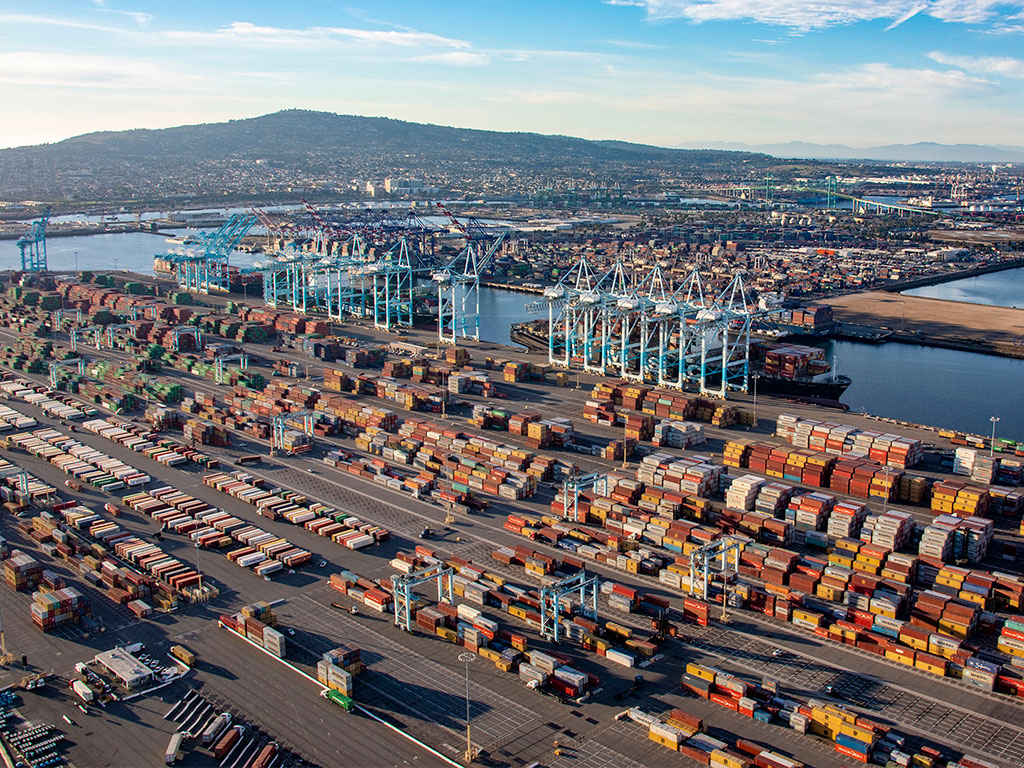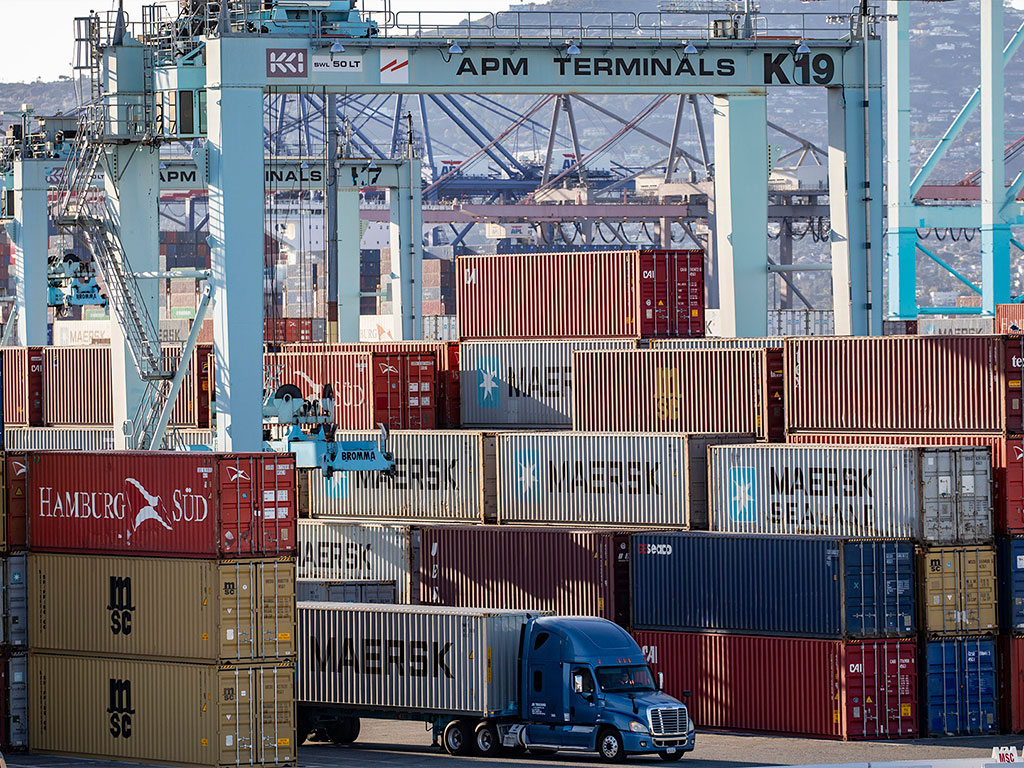Ports, carriers, and tech companies are working on better intermodal visibility
In July, the Port of Los Angeles announced the launch of a cargo-volume predictor, called Horizon, to provide shippers, terminal operators, truckers, and rail carriers a picture of container movements at the port six months in advance. The feature, an addition to the port’s larger digital technology platform, uses an algorithm based on historical and trending volume data to issue monthly volume updates half a year ahead.
Tools like Horizon, if used across other North American gateways, could help alleviate the visibility problems facing intermodal transportation. Intermodal volumes have been surging as demand for goods increased during the pandemic, yet rail carriers are having difficulty matching capacity with demand—largely because they don’t have visibility to incoming containers. Many shippers also lack visibility once shipments hit the intermodal system.
The Amazon effect, as some call it, means that shippers and consumers alike want to track shipments from release to delivery—for e-commerce packages and business-to-business shipments—but this capability is laggard in the intermodal sector. “In today’s supply chain, everyone needs to know where their shipments are at all times,” said Ward Proctor, director of business solutions at TransmetriQ, a provider of an intermodal visibility tool.

Complex Supply Chain
The good news is that ports like Los Angeles, as well as transportation providers and technology developers, are putting systems and processes in place to improve the situation. These tools include direct connectivity, but they are also increasingly employing artificial intelligence and predictive analytics to provide more accurate estimated times of arrival (ETAs).
Part of the problem for intermodal is that its complex supply chain includes many stakeholders, such as ports, drayage truckers, warehouses, intermodal marketing companies (IMCs), and railroads. Visibility to the first mile is “where the fog sets in,” according to Glenn Jones, global vice president of product strategy at Blume Global a provider of an intermodal technology platform. “Knowing that freight has begun its journey is the start of being able to predict ETA.”
Many railroads have tools in place to provide cargo status to their clients, noted Tom Forbes, vice president of Navis Rail, a planning platform for freight railroads. “The expansion of this view to include detailed information on incoming or outbound international containers would dramatically improve this visibility,” he added. “But this information is not readily available to all segments of the transportation process.”
One challenge is that railroads rarely directly exchange files with ocean carriers. “There is data sharing between ocean carriers and ocean terminal operators,” said Forbes, “but not necessarily for the benefit of railroads.” That is where a tool like Horizon at the Port of Los Angeles could help extend the availability of data.

Intermodal Visibility
TransmetriQ is developing a solution that provides intermodal visibility across North American railroads. A rebranding of Railinc’s commercial services, TransmetriQ leverages Railinc’s trove of rail data to provide visibility solutions for its customers regardless of which rail carrier is transporting a given shipment. Railinc, a for-profit subsidiary of the Association of American Railroads, provides data and messaging services to North American freight railways.
“In the past, shippers have relied on other parties for this information,” said Proctor. “Depending on the IMC or railroad, they may have had challenges merging disparate data sources to get a complete picture. Putting that together has been complex for shippers.”
TransmetriQ has access to location data through the train reporting messages that railways provide through Railinc. Participating carriers include all seven Class I North American railroads as well as 560 regional and short-line railways across the United States, Canada, and Mexico.
TransmetriQ seeks to disseminate this data to customers of all sizes based on their technology needs and capabilities. “Customers that have in-house capabilities may want to incorporate a push data feed or leverage APIs”—application programming interfaces that connect systems—“to draw data,” said Proctor. “In smaller companies that may not have as robust capabilities, they may need a hosted solution to bring it about.”
Blume Global has applied analytics to the intermodal data that it collects in an attempt to generate more accurate ETAs for its customers. “A terminal might advertise its average dwell time as 36 hours,” said Jones, “but historical data might reveal an actual dwell time of 70 hours, triggering adjustments to estimated times of arrival.”
TransmetriQ’s data science team is now employing artificial intelligence and machine learning neural networks to move beyond analyzing historical information and create models trained with trending data from specific origin-destination pairs. These sequence models are able to recognize and learn key information while ignoring useless data to generate more accurate ETAs on behalf of clients.
“We have worked through some pilots and have shown very promising results compared to historical averages,” said Proctor. TransmetriQ has found accuracy improvements to ETAs of as much as a 20% over older models. “But the system is still evolving,” Proctor emphasized.
“ETA is such an important factor in intermodal,” he added. “When you think about scheduling trains, you need to have reliable idea on when containers are going to arrive.”
TransmetriQ’s goal is to continue to apply machine learning so the system can work autonomously to learn new data, draw better conclusions, and constantly improve. TransmetriQ has also started applying the same technologies to create models to aid in proactively maintaining railroad assets.
Ultimately, clearing the intermodal fog will require all stakeholders to be connected and have visibility to the entire transportation chain. Visibility, Jones noted, also involves “the opportunity to optimize.”
That means ports and railroads will need to know the volume and types of containers that are on their way when a ship sets sail from Asia, according to Forbes, allowing them to put the assets and personnel “in place when the containers hit the pier.” “More complete rail data,” he added, “would be available to share with the customer, earlier in the supply chain.”
These enhanced levels of visibility have “gone from nice to have to must have,” said Proctor. That’s why so many are at work helping intermodal stakeholders answer the now-ubiquitous question, “Where’s my freight?”




